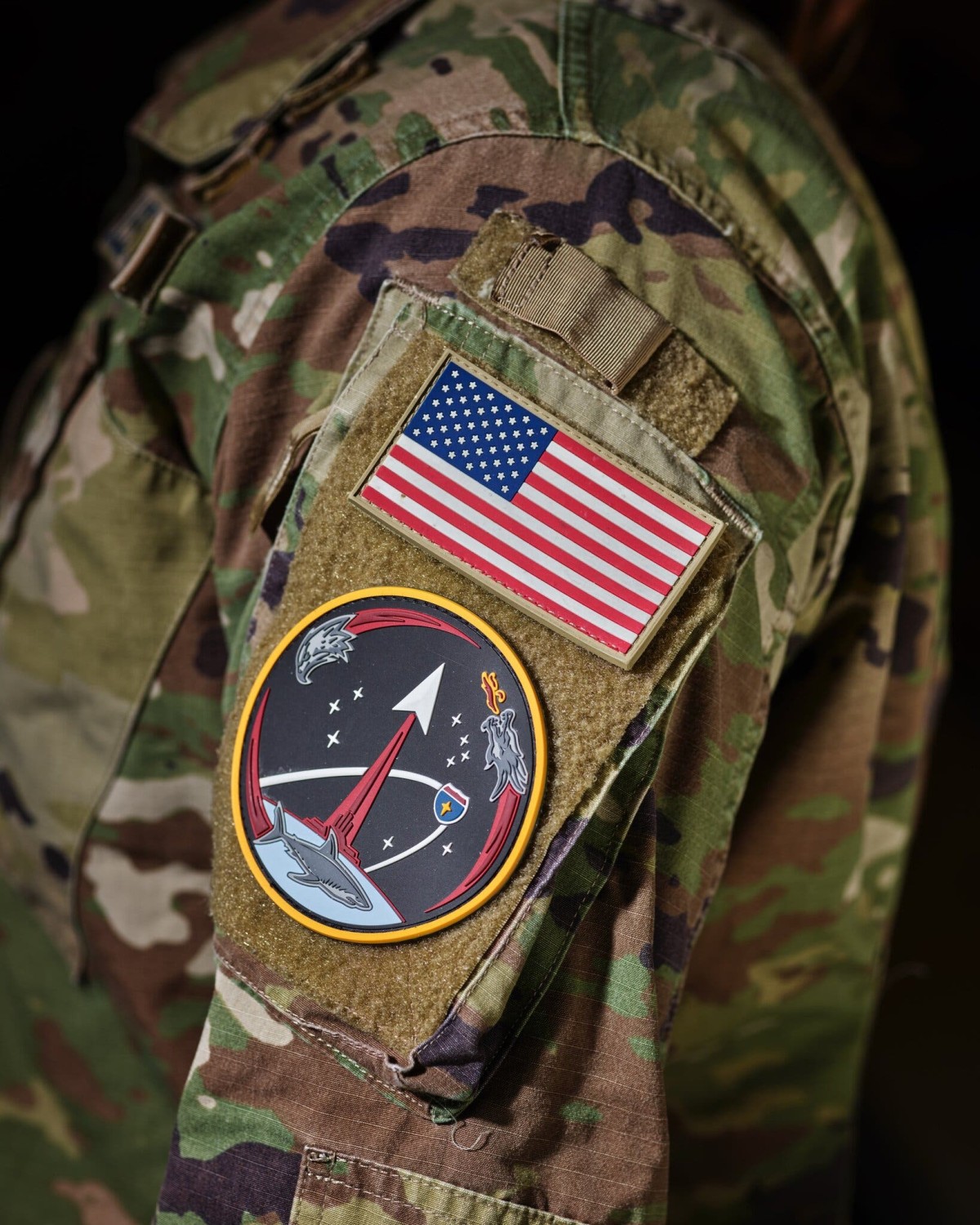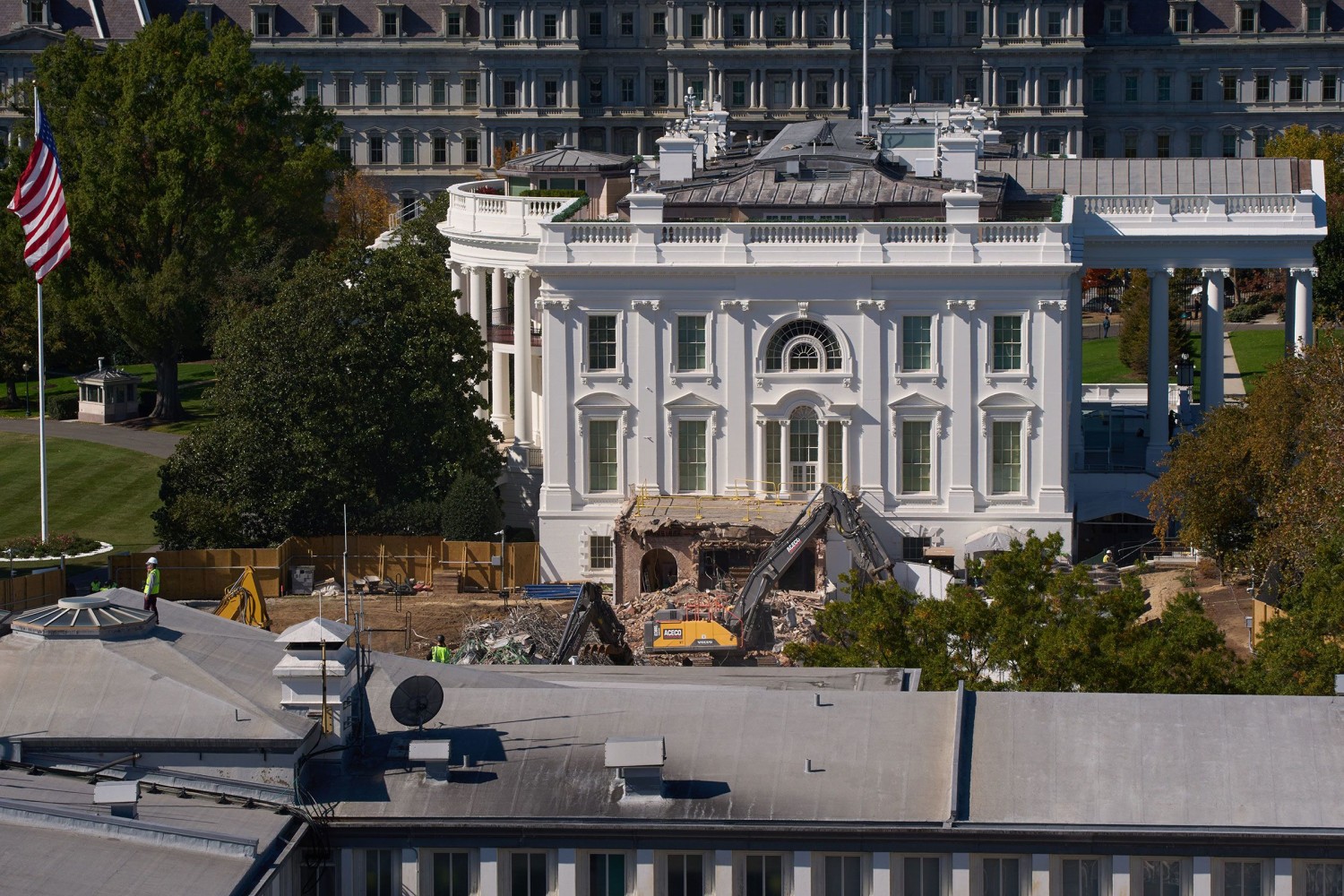
This article is more than
2 year oldWhat Does the U.S. Space Force Actually Do?

What’s most concerning isn’t the swarm of satellites but the types. “We know that there are kinetic kill vehicles,” Lerch said — for example, a Russian “nesting doll” satellite, in which a big satellite releases a tiny one and the tiny one releases a mechanism that can strike and damage another satellite. There are machines with the ability to cast nets and extend grappling hooks, too. China, whose presence in space now far outpaces Russia’s, is launching unmanned “space planes” into orbit, testing potentially unbreakable quantum communication links and adding A.I. capabilities to satellites.
An intelligence report, Lerch said, predicted the advent, within the next decade, of satellites with radio-frequency jammers, chemical sprayers and lasers that blind and disable the competition. All this would be in addition to the cyberwarfare tools, electromagnetic instruments and “ASAT” antisatellite missiles that already exist on the ground. In Lerch’s assessment, space looked less like a grand “new ocean” for exploration — phrasing meant to induce wonder that has lingered from the Kennedy administration — and more like a robotic battlefield, where the conflicts raging on Earth would soon extend ever upward.
The Space Force, the sixth and newest branch of the U.S. military, was authorized by Congress and signed into law by President Donald Trump in December 2019. Its creation was not a partisan endeavor, though Trump has boasted that the idea for the organization was his alone. The initiative had in fact been shaped within the armed forces and Congress over the previous 25 years, based on the premise that as satellite and space technologies evolved, America’s military organizations had to change as well.
At its incarnation, the Space Force was an assemblage of programs and teams that already existed, mainly as entities within the Air Force. “It’s one of the common misperceptions that it cost money to create the Space Force — and it really didn’t, because we already had space forces,” Todd Harrison of the Center for Strategic and International Studies told me. “These were just spread throughout the military: the people, the bases, the platforms, the satellites, the ground stations.” What the new directive did accomplish, however, was to group space endeavors under a central chain of command and authorize its leaders to chart a unified future. “One of the things that we were lacking without a Space Force was an organization that would argue for its own destiny,” Douglas Loverro, a former Pentagon official involved in helping start the branch, told me. The concern was that without a dedicated team within the military’s bureaucracy that could push for the specific tools they needed, the United States would be at a disadvantage. Some strategists worried that the nation already was. Loverro pointed out that two decades ago, a Chinese military analyst named Wang Hucheng wrote a paper that presaged an aspect of China’s aerospace strategy: “For countries that can never win a war with the United States by using the method of tanks and planes, attacking the U.S. space system may be an irresistible and most tempting choice.” The argument identified space as the U.S. military’s “soft ribs” and “strategic weakness.”
From the start, the Space Force had detractors. Air Force officials wondered if it was necessary, while some political observers believed that it signified the start of a dangerous (and expensive) militarization of another realm. What seemed harder to argue against was how nearly every aspect of modern warfare and defense — intelligence, surveillance, communications, operations, missile detection — has come to rely on links to orbiting satellites. The recent battles in Eastern Europe, in which Russia has tried to disrupt Ukraine’s space-borne communication systems, are a case in point. And yet the strategic exploitation of space now extends well beyond military concerns. Satellite phone systems have become widespread. Positioning and timing satellites, such as GPS (now overseen by the Space Force), allow for digital mapping, navigation, banking and agricultural management. A world without orbital weather surveys seems unthinkable. Modern life is reliant on space technologies to an extent that an interruption would create profound economic and social distress.

The work of the Space Force is by its nature highly sensitive, often classified and mostly out of sight. This leaves the organization in a battle for visibility and, at times, viability. Some members of the force — guardians, as they’re called — told me that even now they find themselves bumping into members of other branches of the military who see their arm patches and ask, in earnest: “Space Force, is that a real thing?” The Steve Carell Netflix comedy series, which members of the actual Space Force sometimes argue is neither good nor funny, doesn’t help their cause.
It likewise doesn’t capture their seriousness of purpose. For the moment, the force has taken up a problem not often contemplated outside science fiction: How do you fight a war in space, or a war on Earth that expands into space? And even if you’re ready to fight, how do you make sure you don’t have a space war in the first place?
The Space Force’s operations division is headquartered on the southeastern side of Colorado Springs, in a massive three-story building within the guarded perimeter of Peterson Space Force Base. Until recently, it was Peterson Air Force Base. The office’s inner workings are highly secure and secretive; the force, as one security analyst told me, has a larger proportion of its budget — around $26 billion this year — dedicated to classified spending than any other branch of the military. Visitors to headquarters are not allowed to bring electronic devices or walk unescorted inside. The building nevertheless hums with activity, with personnel hustling about under a canopy of scale-model satellites, large replicas of machines that now orbit Earth, hanging in a bright, airy atrium.
When I visited in late September, several military and civilian personnel took me through their day-to-day work. Right away they noted that the Space Force is often mistaken for United States Space Command, also headquartered in Colorado, that reports to the U.S. secretary of defense. Space Command is a decision-making entity that coordinates space-related operations for all branches of the armed forces. The Space Force, by contrast, outfits and trains troops for potential space conflicts, scrutinizes space for dangers and launches satellites for the Department of Defense. The Space Force regularly consults with Space Command to ask how (or whether) the potential threats it discovers should be addressed.
As large as the Space Force’s remit seems to be — to monitor, protect and ensure access to a territory far larger than Earth’s oceans — technology now enables economies of scale. “It’s a big domain with the smallest force, smaller than the Coast Guard,” Christopher Ayres, the technical director to the deputy commanding general for operations, explained. All told, the Space Force has about 8,600 military guardians and about 5,000 civilian guardians. But you don’t need hundreds of people to operate a satellite after launch. You may need only one. Space Force personnel often do their work in air-conditioned, windowless buildings, outfitted with computer servers and robust intelligence links. During critical situations, they “deploy in place” — that is, they report to the same offices but at a heightened state of readiness.

Guardians tend to think of the realm they patrol as a kind of structured multilevel terrain — Earth as being surrounded by three highways, or three rings. The nearest level, low Earth orbit (LEO), is host to constellations like SpaceX’s Starlink network and the International Space Station, which moves about 250 miles above us at 17,500 miles per hour. A medium Earth orbit (MEO), between 1,200 and 22,000 miles above, is where GPS satellites circle. At the highest ring — at least for now — is a track known as “geosynchronous” orbit (GEO), because an object in such an orbit keeps pace with Earth’s rotation. This band is home to DirectTV satellites, weather-tracking instruments from the National Oceanic and Atmospheric Administration and crucial Defense Department communication links.
It’s a technological zoo up there. The satellite mix is foreign and domestic, young and old, sinister and peaceful. The technologies are all different sizes, flying at different speeds and altitudes. The challenge for the force is to monitor all movement but also to track the threatening presence of debris, some of which is naturally occurring (tiny rocks, for instance) and some of which has human origins (like shards of old rockets). Because space junk can move at extraordinary velocities, a floating screw might pack a destructive punch equivalent to a small bomb.
The main focus within the Space Force is on observation and deterrence — nobody wants a space war, I was reminded frequently. But the force has a capacity to mobilize when necessary. At Peterson, I visited an electromagnetic-warfare center, a building not far from headquarters — but ringed with surveillance cameras and an additional perimeter of high fencing — where men and women train to unjam signals that may be intentionally interfering with American planes, ships and ground troops. “It would be like watching TV and you can’t get the signal,” Lt. Col. D.J. Thomas, who leads the team, told me. In emergencies, Thomas said, his guardians would pack up a pair of portable dish antennas and a customized computer console at a moment’s notice (a combined unit that struck me as fitting easily into a minivan) and ship out to remote locations all over the world.
The rooms I visited at the electromagnetic-warfare center were for defensive training. A part of the building was given over to offensive tactics. Clearly, the force sees both as necessary. And if a requirement to “blind and deafen” an enemy’s satellites were to arise from U.S. Space Command, the Space Force could help fulfill the order. The means would most likely not be “kinetic” — some form of physical or explosive contact — but electronic, a weapon of code-related stealth, or perhaps a kind of debilitating high-energy burst. Col. Chandler Atwood of Space Force Operations Command told me that what concerns him most is his belief that Americans are unaware of how rapidly orbital dangers have evolved. He acknowledged that the force observes “multiple events daily” in space that require its attention. “It’s not the kinetic threat that keeps me up at night,” he added. “It’s the cyberdefense aspect. We have significant vulnerabilities we have to harden up.”

From Peterson, I took a 30-minute ride to a smaller Space Force base in Colorado known as Schriever, which sits on a grassy plain with a distant view of Pikes Peak. To reach the Space Force’s orbital-warfare unit meant passing through a gated station at the base’s perimeter and barriers of high protective fencing, monitored by guards with body armor and weapons. Lt. Col. Galen Thorpe escorted me inside the complex. The most crucial part of his work occurs inside a building where about 120 guardians, working in teams of five at a time, “push buttons,” as Thorpe put it, to drive five maneuverable observation satellites known as GSSAPs (for the Geosynchronous Space Situational Awareness Program) at a distance of 22,300 miles above Earth. Unlike many satellites, which cannot be significantly steered once they’re put into orbit, these have tanks of propellant and are akin to enormous remote-controlled drones.
The program was originally created inside the Air Force. I asked Thorpe how things had evolved since his unit was reconfigured within the Space Force three years ago. He pointed to a “shift in posture” — from merely cataloging all the satellites in orbit to scrutinizing their behavior, using tools like GSSAPs, in terms of “threat awareness.” Or, as he put it, “We have to know where these objects are in a protect-and-defend sense.”
Thorpe’s colleague, Capt. Raymond Pereira, drawing on a white board, pointed me to another concern: the crowd of satellites in low Earth orbit. “I would say we’re probably already entering into an area where congestion is a problem,” he said, “and anything that would generate debris would be catastrophic for the domain.” One plausible theory is known as the Kessler Syndrome, named after the former NASA scientist Donald Kessler, which posits that a release of wreckage and fragments in this orbit could eventually lead to a domino effect of unstoppable destruction. Pereira pointed out that if someone (or something) were to touch off such an event, “they would not only be harming their adversary; they would be harming themselves.” But even short of that, a single collision or attack might hamstring science missions to the moon, or to Mars, or lead to failures for GPS and communications systems, a problem that could have huge consequences for life on Earth.
Keeping track of 44,500 items moving around the planet, along with new arrivals that slip into orbit nearly every week, poses a multidimensional task: Who launched these machines? Why? What could they do? “We need to know what’s up there, where is it going and why we should be concerned,” Col. Bryon McClain of the Space Force told me. This goal, known as space-domain awareness, has become one of the force’s overarching priorities. There are enormous challenges in creating a system of constant observation and making sense of so much data. What constitutes threatening activities in orbit, moreover, and what might necessitate a strategic response is not always clear. In truth, space has few unquestioned laws apart from those relating to gravity. A treaty from the late 1960s, signed by most of the major nations on Earth, prohibits the use of nuclear weapons in space and designates the moon for peaceful purposes. But recently, I was told, satellites from foreign adversaries have been coming close to machines from the United States and its allies. The treaty says nothing about such provocations — or about grappling hooks, nesting dolls and cyberwarfare.

Space Force leaders readily describe their guardians as working toward a state of combat readiness, even as they hope an era of actual conflict never arrives. In October, I went to the Pentagon to meet with Gen. Chance Saltzman, the chief of space operations and the Space Force’s highest-ranking officer. Saltzman remarked that several decades back, when he began working with satellites in the Air Force, the notion that there could be combat losses in space was not part of the conversation. But “those are discussions now,” he told me, “because both the Chinese and the Russians have demonstrated operational capabilities that truly placed those assets at risk.” In 2007, China’s decision to test an ASAT weapon to destroy one of its own satellites sent shock waves through the U.S. military and created a vast field of debris. A similar Russian tactic, in 2021, generated more than 1,500 fragments and led Secretary of State Antony Blinken to describe the act as “recklessly conducted.” The Space Force’s own squadrons, Saltzman told me, were still tracking pieces of junk that date to the 2007 explosion. “You know, the other domains kind of clean themselves up after war,” Saltzman said. “You shoot an airplane down, it falls out of the sky. Ships sink out of the sea lanes. Even on land, you bring the bulldozers in and you move things around. But space doesn’t heal itself.”
Debris has led military strategists to ponder a related issue: In space, it’s difficult to get out of the way of conflict. Right now, Saltzman noted, if you pull up real-time data to see where flights are around the world, the airspace over Ukraine is empty. “You will see a void,” he said. “Commercial air traffic does not want to fly over Ukraine.” The same thing happens in shipping lanes, like the Strait of Hormuz, when the Middle East is in turmoil, as it is now. “So in other domains, refugees, displaced persons, people get out of the way of conflict. Commercial entities move out of the way and avoid conflict.” In space, orbital mechanics take over; machines keep going around and around, following the laws of gravity. NASA satellites may not be able to steer away from a potential combat zone. And commercial entities can’t move — or won’t know where or when to move. “And then potentially every satellite becomes more debris,” Saltzman remarked. “Every peaceful satellite could become a weapon accidentally.”
I asked Saltzman what he and his colleagues had learned from observing the war in Ukraine. With a caveat that the fighting is hardly over — “it could still be a catastrophe on a grand scale,” he said — he pointed to several crucial events. The first was how one of Russia’s earliest endeavors was to deny Ukrainian troops access to a satellite communications system they relied upon, known as Viasat, which is stationed in the distant geosynchronous orbital belt. “And they did it with a cyberattack against the ground infrastructure,” he said. “So you attack the ground network to achieve the space effect you want.” This wasn’t a surprise to him, he said, yet it was a reminder of the potential power of cyberwarfare and how battles to dominate space could still be terrestrial.
Another crucial point came after that attack — Ukraine’s decision to go to a commercial vendor, SpaceX, and use its Starlink system for combat communications. Here the lesson was twofold. First, that what Saltzman called “commercial augmentation” could prove vital in a crisis. As important, he added, Starlink — a configuration of hundreds of “proliferated” small satellites flying in low Earth orbit — has proved hard to bring down. “The Russians are trying to interrupt it,” he said, “and they’re not having very good success.” And the takeaway is that proliferated systems of many small machines in low orbit can be more technologically resilient to hacking and disruption than a few big machines in higher orbits. This seems to fit into Saltzman’s goal of maintaining strength during combat while achieving a larger objective of avoiding conflict altogether. “If I have two or three satellite communications doing nuclear command and control, maybe those are targets,” he explained. “But if I take nuclear command and control and spread it across 400 satellites that are zipping over the horizon [every] 15 minutes, there’s a targeting problem. How many satellites do I have to shoot down now to take out the U.S. nuclear command and control?”

If the answer was 400, it would make things difficult for the enemy. And while small satellites in a large configuration could potentially be a more expensive investment than two or three megasatellites, the shift could be worthwhile. If an adversary believes that it cannot achieve a military objective, Saltzman remarked, it will hesitate to cross “a threshold of violence.” No conflicts. No debris. No crisis.
Over the course of several days in Los Angeles at Space Systems Command — a Space Force division that plans and acquires technology — I met with about a dozen colonels who detailed their ideas for the next decade. Some discussions addressed the Space Force’s goal of being able to launch satellites within, say, 24 hours in urgent situations. I learned the force is working on developing machines that can be refueled in orbit, as well as satellites that can repair other satellites. Because rockets and orbital objects travel so fast — the International Space Station circles Earth every 90 minutes — some tacticians are pondering being able to deliver, via launches into space, a high-value package, such as a rare medication or a vital part for an F-35 fighter jet, halfway across the world in as little as 30 minutes.
Other projects are less speculative. There are deep concerns within the military about China and Russia’s hypersonic glide weapons,which may be able to avoid defense systems through bursts of speed and pretzeled flight paths. In response, the force is trying to implement a new system of detection in the next several years at low and middle Earth orbits. It took ample funds to build and launch the old systems, Col. Heather Bogstie, who helps oversee the program, told me. “But with the speed our adversaries are fielding these hypersonic glide vehicles, we don’t have the luxury of time anymore.”
Brian Weeden of the Secure World Foundation, a nonprofit that focuses on keeping the orbital realm peaceful and sustainable, told me that the U.S. military has faced perennial challenges in reducing costs and delivery times for new space-based projects — and that the Space Force has yet to prove it can buck that trend. Still, the force is trying to nurture America’s domestic rocket industry — acting as a facilitator for national-security launches while stoking the growth and bringing down the expense of fledgling commercial enterprises. The Department of Defense sometimes requires big rockets to take heavy satellites farther into space — that is, into the MEO or GEO layers — making for significant technical challenges for new companies. Col. Douglas Pentacost, the deputy director of launch enterprise at Space Systems Command, also told me that because some launches carry “very precious,” “supersecret” instruments, they cannot fail under any circumstances.
For now, SpaceX has demonstrated the capabilities and safety record to carry these payloads. But Pentacost told me: “We can’t rely on one company to always be there for us. That’s basically taking us back to the 1980s, when we were relying on the space shuttle. And then when the space shuttle had its unfortunate accident, we had no way into space for several years.” In an effort to diversify risks, Pentacost’s team is working with the United Launch Alliance, a partnership of Lockheed Martin and Boeing. Commercial companies — Firefly, Rocket Lab and Jeff Bezos’s Blue Origin, for instance — are in the mix, too. The goal would be a range of reliable and cheaper launch companies to choose from by the late 2020s. Pentacost said he would soon like to be able to get any payload into orbit at any time.

There is a darker side that accompanies a future of rampant growth. As space becomes commercialized, it increasingly becomes a geopolitical arena for competition too. Just as China launched a space plane that stayed aloft for months, so has the U.S. Space Force. Just as competitors develop satellites that make close and unnerving approaches to our satellites, so does the U.S. Space Force. With so many launches now planned, and so many designs for enigmatic satellites in the works, it becomes hard not to wonder if the United States will become engaged in a new arms race. Or to ask if it already has.
In 1950, a political scientist named John Herz introduced the term “security dilemma,” noting that in international affairs, a state concerned with “being attacked, subjected, dominated or annihilated” by others can be drawn into a “vicious circle” of building up its defenses. One implication of this, a political scientist named Robert Jervis later posited, is that “one state’s gain in security inadvertently threatens others.” When I asked Saltzman if this was a concern, he acknowledged that it was, but he also said that the security dilemma was a phenomenon that probably dated back thousands of years. Weapons are not inherently offensive or defensive, Saltzman maintained. “Weapons are just weapons. And the operations that you choose to undertake with those weapons makes them more offensive or defensive.”
The important question, as he saw it, was this: At what point does a buildup of defensive weapons in space constitute an ability to conduct offensive operations so that someone else feels threatened? “There is a balance here,” he said. “And this is about stability management. What actions can we take to protect ourselves before we start to cross the line and maybe create a security dilemma?” The line, he suggested — harder to find in space, no doubt, and at this point not clearly defined — had not yet been crossed.
Jon Gertner has been writing about science and technology for the magazine since 2003. He last wrote about A.I.’s threats to Wikipedia. Christopher Payne is a photographer specializing in architecture and industry. His new book, “Made in America,” was published in October.




